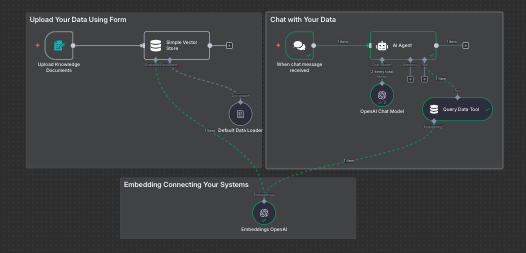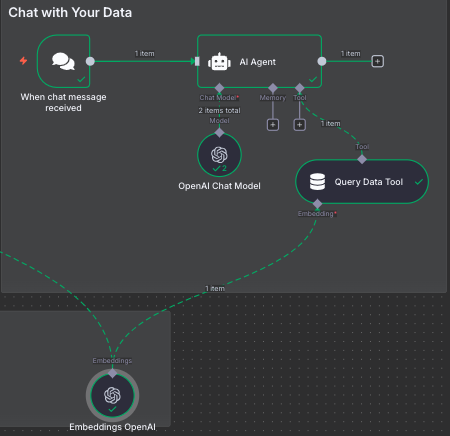Chat With Your Documents: Build a RAG AI Agent with No Code in 20 minutes
In my previous tutorials, you built AI agents for web scraping and conversations. Today: teach an AI to answer questions about YOUR documents.
What you're building: A simple chatbot that reads your documents and answers questions with accurate information—no hallucinations.
What you need: N8N account, OpenAI API key, a document, 20 minutes.
Why This Matters
ChatGPT doesn't know your company policies, resume, or product docs. RAG (Retrieval-Augmented Generation) fixes this by letting AI pull from YOUR documents before answering.
Without RAG: "Tell me about my work experience" → Generic advice With RAG: Specific details from your resume about Johns Hopkins, Morgan State, your M.Sc.
This is how companies build internal assistants, support bots, and knowledge bases.
How It Works
Two workflows that share data:
Workflow 1 - Upload: Document → Breaks into chunks → Converts to vectors → Stores in database
Workflow 2 - Chat: Chat → AI Agent → Chat Model→ Searches database → AI reads chunks
Vectors are coordinates on a mathematical map. Similar meanings = close together. When you ask "What university?", it finds education chunks, not hobby chunks.
Build Part 1: Upload Workflow
Step 1: Create workflow, add Form Trigger
Add form field: Type = File, Name = "document", Accept =
.pdf,.txtForm Title: "Upload Knowledge Document"
Step 2: Add Simple Vector Store (not connected yet)
Mode: Insert Documents
Memory Key:
my-knowledge-base(critical—you'll reuse this)
Step 3: Click Vector Store's "Document Loader" port → Add Default Data Loader
Text Splitter: Recursive Character Text Splitter
Chunk Size: 1000, Overlap: 200
Step 4: Click Vector Store's "Embedding" port → Add Embeddings OpenAI
Model: text-embedding-3-small
Add your API key
Step 5: Execute workflow, upload test document, verify chunks created.
In my case, I have created .txt file with the content of my resume to be used for testing
Build Part 2: Chat Workflow
Step 1: New workflow, add When chat message received
Public Chat: ON
Initial Message: "Ask me anything about uploaded documents"
Step 2: Add AI Agent, connect to Chat Trigger
Prompt:
You answer questions using only the knowledge base.
If no relevant info found, say "I don't have that information."
Be specific. Cite details.
Step 3: Click Agent's "Model" port → Add OpenAI Chat Model
Model: gpt-4o-mini
Temperature: 0.2 (factual, not creative)
Step 4: Click Agent's "Tools" port → Add Simple Vector Store
Mode: Retrieve Documents (as Tool)
Memory Key:
my-knowledge-base(MUST MATCH upload workflow)Description: "Search knowledge base for facts, dates, names, details"
Limit: 4
Step 5: Click this Vector Store's "Embedding" port → Add Embeddings OpenAI
Model: text-embedding-3-small (MUST MATCH upload workflow)
Step 6: Execute, get chat URL, ask questions about your document.
Real Example
I uploaded my resume. Asked: "What university did the candidate go to?"
Response: "Johns Hopkins University (M.Sc. Engineering Management, May 2016) and Morgan State University (B.Sc. Electrical Engineering, May 2013)."
No hallucination. Just facts from my document.
Common Issues
"I don't have that information" but it's clearly there:
Both workflows must use identical Memory Key
Increase Limit to 6 chunks
Decrease chunk size to 500-700
AI uses general knowledge instead of documents:
Add to prompt: "NEVER use training data. ONLY use knowledge base tool."
Production Upgrades
Simple Vector Store works for learning but data clears on restart.
For production:
Pinecone/Qdrant: Persistent storage
Authentication: Add password/API key protection
Metadata: Tag documents by department/date for filtering
Cost monitoring: Track OpenAI API usage
What You Built
Document → Chunks → Vectors → Storage → Search → Answer
This architecture powers:
HR bots ("What's our vacation policy?")
Support bots ("How do I reset password?")
Research assistants (50-paper summaries)
Documentation bots ("How do I use this API?")
Subscribe for the next tutorial. Tag me on LinkedIn if you build something.
The insight: Companies winning with AI use better systems, not better models. You just built one.
Resources: N8N RAG Docs | RAG Template



